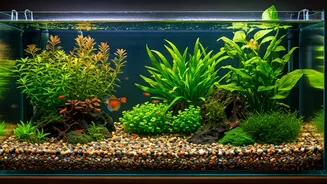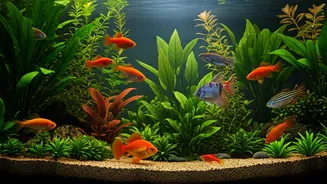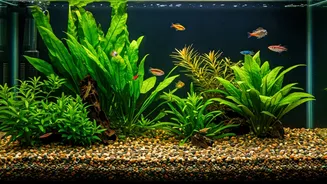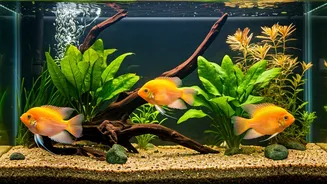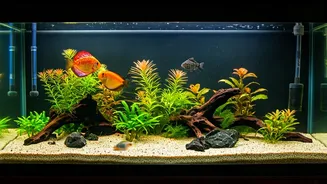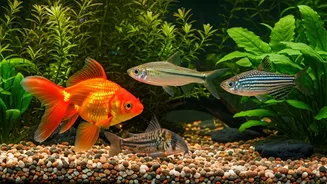Introduction: Aquarium Basics
Setting up an aquarium can be a rewarding hobby. Before introducing fish, understanding the basics is essential for their well-being. This includes knowing
about the nitrogen cycle, which is fundamental to maintaining water quality by converting harmful waste products into less toxic substances. Regular water changes and proper filtration are also key to keeping the water clean and suitable for fish. The size of the tank, the type of filtration system, and the overall setup all play vital roles in the health of the aquarium environment. Careful planning and initial preparation can significantly increase the chances of a successful and enjoyable experience for any new fish keeper.
Guppy: The Colorful Choice
Guppies are renowned for their vibrant colors and ease of care, making them perfect for beginners. They are small, typically growing to about 2.5 inches, and thrive in community tanks with a temperature range of 72-82°F (22-28°C). Guppies are livebearers, meaning they give birth to live young, leading to rapid population growth in well-maintained tanks. They are not overly demanding regarding water parameters but still benefit from regular partial water changes. Feeding guppies is straightforward; they accept flake food, supplemented with occasional treats like brine shrimp or bloodworms. Their lively behavior and stunning appearance make them a delightful addition to any beginner's aquarium.
Betta: The Siamese Fighter
The Betta, also known as the Siamese fighting fish, is another popular choice due to its striking appearance and relatively low maintenance needs. Male Bettas are best kept alone to prevent fighting. They can thrive in a tank as small as 5 gallons, with a temperature range of 76-82°F (24-28°C). Bettas are labyrinth fish, meaning they have a special organ that allows them to breathe air from the surface, so a well-oxygenated tank is crucial. They are carnivorous and should be fed a diet of betta pellets, bloodworms, or brine shrimp. Proper care involves keeping the water clean and providing a suitable environment with plants or decorations for them to explore. Regular observation for signs of stress or illness will help ensure the betta stays healthy.
Neon Tetra: Shimmering Beauty
Neon Tetras are famed for their vivid neon stripes that make them a visually appealing addition to any community tank. These small, peaceful fish generally grow up to about 1.5 inches and do best in groups of six or more, creating a schooling effect that is very pleasing to watch. They prefer a temperature range of 72-78°F (22-26°C) and slightly acidic water conditions. Neon Tetras are quite sensitive to changes in water parameters, so a stable environment is essential. They are omnivores, readily accepting flake food and small live or frozen foods. A planted tank setup helps them feel secure and highlights their vibrant colors, making them an excellent choice for a well-maintained community aquarium.
Platy: A Hardy Option
Platies are another excellent choice for beginners due to their hardiness and attractive appearance. They come in various colors and patterns and generally grow to about 2.5 inches. They are livebearers, and like guppies, they can reproduce quickly, so managing their population might be necessary. Platies thrive in temperatures ranging from 70-80°F (21-27°C) and adapt well to various water conditions. They are omnivorous and will eat flake food, vegetables, and small invertebrates. A well-decorated tank with ample swimming space and hiding places will make them happy. Their friendly nature and adaptability make them a reliable choice for beginners looking for low-maintenance, colorful fish.
Corydoras: The Cleaners
Corydoras, or Cory cats, are bottom-dwelling catfish that are valued for their helpful role in keeping the tank clean. They come in various species, ranging in size from 1 to 4 inches. These fish are peaceful and should be kept in groups of at least three to maintain their social needs. They prefer a temperature range of 72-82°F (22-28°C) and a substrate of sand or smooth gravel to protect their barbels. Corydoras are omnivores and will eat sinking pellets, flakes, and any uneaten food that settles at the bottom. They are fun to watch and contribute to a healthier aquarium environment by scavenging for leftover food and keeping the substrate clean.
Molly: Versatile and Hardy
Mollies, available in different varieties, are known for their hardiness and ability to adapt to a range of water conditions. They can grow up to 4 inches and need a tank size appropriate for their adult size. Mollies thrive in temperatures between 72-82°F (22-28°C) and prefer slightly brackish water, but some varieties do well in freshwater. They are livebearers and require adequate space to avoid overcrowding. Mollies are omnivorous, eating flake food and supplementing with algae and vegetables. Providing a diverse diet and maintaining a stable environment are key to their health, making them a good option for beginners willing to do extra research on their specific needs.
Dwarf Gourami: Peaceful Beauty
Dwarf Gouramis are a stunning addition to the aquarium due to their vibrant colors and peaceful temperament. They typically reach about 2 inches in size and thrive in a well-planted tank with a temperature range of 77-82°F (25-28°C). They are labyrinth fish, like Bettas, and can breathe air from the surface. Dwarf Gouramis prefer calm water conditions and are best kept with other peaceful fish. They are omnivores, enjoying a diet of flake food, live, and frozen foods. Providing ample hiding places and maintaining stable water parameters contributes to their well-being and enhances the overall beauty of the aquarium.
Zebra Danio: Lively and Fun
Zebra Danios are incredibly active and resilient fish, making them a great choice for beginners. These small fish grow up to 2 inches and are known for their distinctive striped patterns. They adapt well to a wide range of water conditions and prefer a temperature range of 65-75°F (18-24°C). Danios should be kept in groups of at least six to feel secure and showcase their schooling behavior. They are omnivorous and will eat flake food and small live or frozen foods. Their active nature and hardiness make them an excellent species to add lively movement to any community tank, thriving in various environments.
Cherry Shrimp: The Algae Eaters
Cherry Shrimp are small, colorful invertebrates ideal for beginner aquarists who want to explore beyond fish. They are freshwater shrimp that can reach about 1.5 inches in size and come in various shades of red. Cherry shrimp thrive in a well-planted tank with a temperature range of 65-80°F (18-27°C) and prefer stable water conditions. They are excellent algae eaters, helping to keep the tank clean, and they are peaceful, making them suitable for community tanks. They feed on algae, biofilm, and any decaying plant matter. Providing them with hiding places and avoiding harsh chemicals or aggressive tank mates is crucial for their survival and health.
